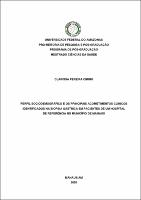| ???jsp.display-item.social.title??? |


|
Please use this identifier to cite or link to this item:
https://tede.ufam.edu.br/handle/tede/8033Full metadata record
| DC Field | Value | Language |
|---|---|---|
| dc.creator | Cirino, Clarissa Pereira | - |
| dc.creator.Lattes | http://lattes.cnpq.br/9618239329338587 | por |
| dc.contributor.advisor1 | Bik, Jonas | - |
| dc.contributor.advisor1Lattes | http://lattes.cnpq.br/5345312521055243 | por |
| dc.contributor.referee1 | Nakajima, Gerson Suguiyama | - |
| dc.contributor.referee1Lattes | http://lattes.cnpq.br/7883304438378279 | por |
| dc.contributor.referee2 | Carneiro, Lilian Carla | - |
| dc.contributor.referee2Lattes | http://lattes.cnpq.br/6506744224041777 | por |
| dc.date.issued | 2020-09-24 | - |
| dc.identifier.citation | CIRINO, Clarissa Pereira. Perfil sociodemográfico e os principais acometimentos clínicos identificados na biópsia gástrica em pacientes de um hospital de referência no município de Manaus. 2020. 75 f. Dissertação (Mestrado em Ciências da Saúde) - Universidade Federal do Amazonas, Manaus, 2020. | por |
| dc.identifier.uri | https://tede.ufam.edu.br/handle/tede/8033 | - |
| dc.description.resumo | As lesões gástricas são comuns na prática clínica, com maior prevalência na América Latina, responsáveis pelo desenvolvimento de neoplasias gástricas malignas, sendo estas a segunda maior causa de mortes. Em virtude disso, o presente trabalho teve por objetivo analisar os principais acometimentos e o perfil clínico-epidemiológico dos pacientes que foram submetidos à biópsia gástrica em um hospital de referência no município de Manaus. Para isso, foi realizado um estudo retrospectivo, observacional, descritivo, transversal, em que se avaliou o perfil clínico-epidemiológico dos pacientes que foram submetidos à biópsia gástrica, durante o período de julho de 2019 a novembro de 2019. Observou-se que, dentre os 70 participantes da pesquisa, a maioria era do gênero feminino, ou seja, 58,6% e o sexo masculino correspondeu a 41,4%. Enquanto que 48,6% apresentavam histórico familiar de câncer, 57,1% eram etilistas, 42,9% tabagistas, 50% consumiam uma alimentação rica em sódio e 62,9% tinham diagnóstico de Helicobacter pylori. Além disso, observou-se, também, que 90% dos participantes da pesquisa tinham um período de espera, para a coleta da biópsia gástrica, superior a oito meses, que os impedia de iniciar o devido tratamento ou a identificação do seu estadiamento. Identificou-se, por meio das biópsias gástricas, que há uma prevalência no número de casos de pacientes com gastrites. Variáveis sociodemográficas como idade, sexo, renda familiar associados a presença de infecção pela bactéria H. pylori, mostram uma maior predisposição ao desenvolvimento de lesões neoplásicas. Em virtude disso, é essencial que sejam identificadas, precocemente, as lesões gástricas para que se possa atuar de forma preventiva. | por |
| dc.description.abstract | Gastric lesions are common in clinical practice, with higher prevalence in Latin America, responsible for the development of malignant gastric neoplasms, which are the second largest cause of death. Because of this, the present work aimed to analyze the main involvement and clinical-epidemiological profile of patients who underwent gastric biopsy at a reference hospital in the city of Manaus. For this purpose, a retrospective, observational, descriptive, cross-sectional study was carried out evaluating the clinical-epidemiological profile of patients who underwent gastric biopsy during the period from July 2019 to November 2019. It was observed that, among the 70 participants in the survey, most were female, i.e., 58.6% and the male gender corresponded to 41.4%. While 48.6% had a family history of cancer, 57.1% were ethylists, 42.9% smokers, 50% consumed a diet rich in sodium and 62.9% were diagnosed with Helicobacter pylori. In addition, it was observed that 90% of the participants of the research had a waiting period, for the collection of the gastric biopsy, superior to eight months, which prevented them from starting the proper treatment or identification of their staging. It was identified through gastric biopsies that there is a prevalence in the number of cases of patients with gastritis. Sociodemographic variables such as age, gender, family income associated with the presence of H. pylori bacteria infection, show a greater predisposition to the development of neoplastic lesions. Because of this, it is essential that gastric lesions are identified early in order to act preventively. | por |
| dc.format | application/pdf | * |
| dc.thumbnail.url | https://tede.ufam.edu.br//retrieve/42330/Disserta%c3%a7%c3%a3o_ClarissaCirino_PPGCS.pdf.jpg | * |
| dc.language | por | por |
| dc.publisher | Universidade Federal do Amazonas | por |
| dc.publisher.department | Faculdade de Medicina | por |
| dc.publisher.country | Brasil | por |
| dc.publisher.initials | UFAM | por |
| dc.publisher.program | Programa de Pós-graduação em Ciências da Saúde | por |
| dc.rights | Acesso Aberto | por |
| dc.subject | Lesões gástricas | por |
| dc.subject | Biópsia gástrica | por |
| dc.subject | Lesões neoplásicas | por |
| dc.subject | Neoplasia gástrica maligna | por |
| dc.subject | Pólipos intestinais | por |
| dc.subject.cnpq | CIÊNCIAS DA SAÚDE | por |
| dc.title | Perfil sociodemográfico e os principais acometimentos clínicos identificados na biópsia gástrica em pacientes de um hospital de referência no município de Manaus | por |
| dc.type | Dissertação | por |
| dc.subject.user | Lesões | por |
| dc.subject.user | Gástricas | por |
| dc.subject.user | Acometimentos | por |
| dc.subject.user | Helicobacter pylori | por |
| Appears in Collections: | Mestrado em Ciências da Saúde | |
Files in This Item:
| File | Description | Size | Format | |
|---|---|---|---|---|
| Dissertação_ClarissaCirino_PPGCS.pdf | Dissertação_ClarissaCirino_PPGCS | 2.28 MB | Adobe PDF |  Download/Open Preview |
Items in DSpace are protected by copyright, with all rights reserved, unless otherwise indicated.




